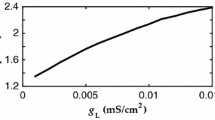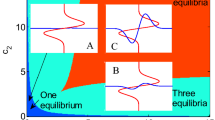Abstract
The neuronal circuit controlling the rhythmic movements in animal locomotion is called the central pattern generator (CPG). The biological control mechanism appears to exploit mechanical resonance to achieve efficient locomotion. The objective of this paper is to reveal the fundamental mechanism underlying entrainment of CPGs to resonance through sensory feedback. To uncover the essential principle, we consider the simplest setting where a pendulum is driven by the reciprocal inhibition oscillator. Existence and properties of stable oscillations are examined by the harmonic balance method, which enables approximate but insightful analysis. In particular, analytical conditions are obtained under which harmonic balance predicts existence of an oscillation at a frequency near the resonance frequency. Our result reveals that the resonance entrainment can be maintained robustly against parameter perturbations through two distinct mechanisms: negative integral feedback and positive rate feedback.
Similar content being viewed by others
References
Brown T. (1911). The intrinsic factors in the act of progression in the mammal. Proc. R. Soc. Lond. 84: 308–319
Grillner S., Buchanan J., Walker P. and Brodin L. (1988). Neural Control of Rhythmic Movements in Vertebrates. Wiley, New York
Orlovsky G., Deliagina T. and Grillner S. (1999). Neuronal Control of Locomotion: From Mollusc to Man. Oxford University Press, New York
Cavagna G., Heglund N. and Taylor C. (1977). Mechanical work in terrestrial locomotion: two basic mechanisms for minimizing energy expenditure. Am. J. Physiol. 233: R243–R261
Rose J. and Gamble J. (2003). Human Walking, 3rd edn. Lippincott Williams and Wilkins, Philadelphia
Hatsopoulos N.G. and Warren W.H. Jr. (1996). Resonance tuning in rhythmic arm movements. J. Motor Behav. 28(1): 3–14
Hatsopoulos N. (1996). Coupling the neural and physical dynamics in rhythmic movements. Neural Comput. 8(3): 567–581
Williamson M. (1998). Neural control of rhythmic arm movements. Neural Netw. 11: 1379–1394
Matsuoka K. (1985). Sustained oscillations generated by mutually inhibiting neurons with adaptation. Biol. Cybern. 52: 367–376
Matsuoka K. (1987). Mechanisms of frequency and pattern control in the neural rhythm generators. Biol. Cybern. 56: 345–353
Friesen W. (1994). Reciprocal inhibition: a mechanism underlying oscillatory animal movements. Neurosci. Biobehav. Rev. 18(4): 547–553
Blaquiere A. (1966). Nonlinear System Analysis. Academic Press, New York
Vidyasagar M. (1978). Nonlinear Systems Analysis. Prentice-Hall, Englewood Cliffs
Khalil H. (1996). Nonlinear Systems. Prentice Hall, Englewood Cliffs
Verdaasdonk B., Koopman H. and der Helm F.V. (2006). Energy efficient and robust rhythmic limb movement by central pattern generators. Neural Netw. 19(4): 388–400
Verdaasdonk B., Koopman H. and der Helm F.V. (2007). Resonance tuning in a neuro-musculo-skeletal model of the forearm. Biol. Cybern. 96(2): 165–180
Williams C. and DeWeerth S. (2007). A comparison of resonance tuning with positive versus negative sensory feedback. Biol. Cybern. 96: 603–614
Simoni M. and DeWeerth S. (2007). Sensory feedback in a half-center oscillator model. IEEE Trans. Biomed. Eng. 54(2): 193–204
Iwasaki T. and Zheng M. (2006). Sensory feedback mechanism underlying entrainment of central pattern generator to mechanical resonance. Biol. Cybern. 94(4): 245–261
Iwasaki, T.: Analysis and synthesis of central pattern generators via multivariable harmonic balance. In: American Control Conference, pp. 4106–4111. Minneapolis, 14–16 June (2006)
Zheng M., Friesen W. and Iwasaki T. (2007). Systems-level modeling of neuronal circuits for leech swimming. J. Comput. Neurosci. 22(1): 21–38. 10.1007/s10827-006-9648-7
Sekerli M. and Butera R. (2005). Oscillations in a simple neuromechanical system: underlying mechanisms. J. Comp. Neurosci. 9: 181–197
Wallen P. and Williams T. (1984). Fictive locomotion in the lamprey spinal cord in vitro compared with swimming in the intact and spinal animal. J. Physiol. 347: 225–239
Yu X., Nguyen B. and Friesen W.O. (1999). Sensory feedback can coordinate the swimming activity of the leech. J. Neurosci. 19(11): 4634–4643
Friesen W. and Cang J. (2001). Sensory and central mechanisms control of intersegmental coordination. Curr. Opin. Neurobiol. 11: 678–683
Iwasaki T. and Shibata G. (2001). LPV system analysis via quadratic separator for uncertain implicit systems. IEEE Trans. Automat. Contr. 46(8): 1195–1208
Pogromsky A., Glad T. and Nijmeijer H. (1999). On diffusion driven oscillations in coupled dynamical systems. Int. J. Bifurcat. Chaos 9(4): 629–644
Author information
Authors and Affiliations
Corresponding author
Additional information
This work is supported by NSF 0237708, NSF 0654070, and NIH/NINDS/CRCNS 1 R01 NS46057-01.
Rights and permissions
About this article
Cite this article
Futakata, Y., Iwasaki, T. Formal analysis of resonance entrainment by central pattern generator. J. Math. Biol. 57, 183–207 (2008). https://doi.org/10.1007/s00285-007-0151-1
Received:
Revised:
Published:
Issue Date:
DOI: https://doi.org/10.1007/s00285-007-0151-1




